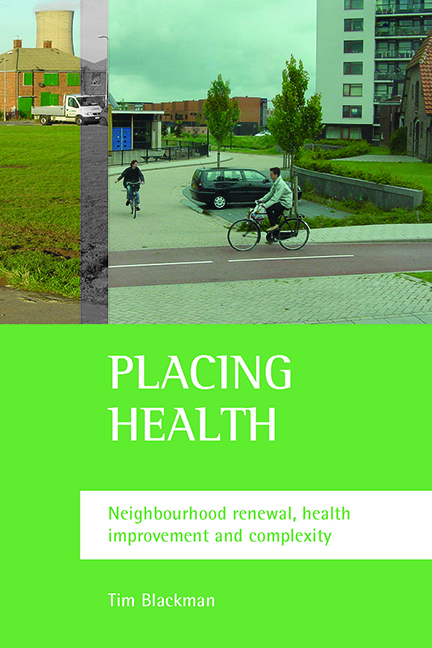Book contents
- Frontmatter
- Dedication
- Contents
- List of tables and figures
- Acknowledgements
- List of abbreviations
- Preface
- one Policy and places
- two Health, neighbourhoods and complexity
- three Emergence and environment press
- four The neighbourhood effect
- five Neighbourhood renewal and health inequalities
- six Health inequality as a policy priority
- seven Conclusion: neighbourhoods in the wider picture
- References
- Index
- Also available from The Policy Press
four - The neighbourhood effect
Published online by Cambridge University Press: 18 January 2022
- Frontmatter
- Dedication
- Contents
- List of tables and figures
- Acknowledgements
- List of abbreviations
- Preface
- one Policy and places
- two Health, neighbourhoods and complexity
- three Emergence and environment press
- four The neighbourhood effect
- five Neighbourhood renewal and health inequalities
- six Health inequality as a policy priority
- seven Conclusion: neighbourhoods in the wider picture
- References
- Index
- Also available from The Policy Press
Summary
It is often argued that communities of propinquity, neighbourhood communities, have declined as people's work and consumption patterns have become wider and more fragmented (Gilleard and Higgs, 2005). This transition has been described in various ways, such as from Fordism to post-Fordism, from ‘organised’ to ‘disorganised’ capitalism, or from modernity to late modernity or post-modernity (Lash and Urry, 1987). In the UK, this new phase space is post-industrial. But although the occupational basis for a neighbourhood identity such as that of a pit village or shipyard community may have largely disappeared, neighbourhoods still often have a material basis in consumption terms. The collective consumption of shared space also takes on a special meaning when it is centred on the home, a place of emotional, financial and labour investment, and where a sense of personal identity and value may be very influenced by how much the neighbourhood is in demand as a place to live. The neighbourhoods of consumer society may be different from the neighbourhoods of industrial society, and part of people's wider and more numerous networks in a more complex society, but they remain meaningful systems, and systems that have effects.
Neighbourhood effect studies
Community studies based largely on qualitative methods have a long history of exploring the distinctiveness of ‘places’ and testing general theories of social change by ‘grounding’ them in specific places (Crow, 2002). In recent years, there has been an expansion of quantitative investigations of whether variations in outcomes such as educational attainment, voting, health status, children's behaviour and domestic violence can to some extent be explained by variation between small-scale geographical contexts once differences between individuals are controlled for statistically. This statistical modelling separates ‘individual’ from ‘neighbourhood’ effects, and in general suggests a much larger effect on health of individual-level variation than neighbourhood-level variation (see Kawachi and Berkman, 2003, for a comprehensive review). Even so, spatial strategies such as ABIs may be able to achieve an appreciable global health gain if they can achieve an improvement in health across large numbers of people.
The evidence about only a small compositional neighbourhood effect is not conclusive. A study by Leyland (2005), for example, suggests that it is area deprivation rather than individual occupational class that is associated with socioeconomic gradients in CVD conditions.
- Type
- Chapter
- Information
- Placing HealthNeighbourhood Renewal, Health Improvement and Complexity, pp. 79 - 108Publisher: Bristol University PressPrint publication year: 2006



